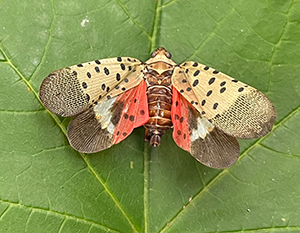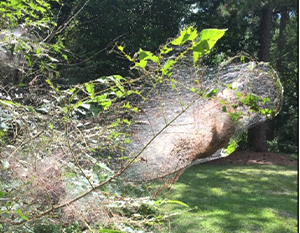Authored by:
Summer may bring sunshine and green canopies, but it also welcomes a host of unwelcome visitors—tree-damaging insects. As temperatures rise, these pests become more active and can wreak havoc on trees already stressed from spring growth or lingering winter effects. Knowing what to watch for can help protect your trees before serious damage sets in.
Southern pine beetle
Southern pine beetle (SPB) is a native beetle that feeds on pine trees and can cause widespread pine mortality. SPB tunnels under the bark which disrupts the tree’s vascular tissue, ultimately leading to tree death. In most years, when SPB populations are low, they generally only attack unhealthy trees. However, SPB can increase to epidemic levels where health trees are attacked, which has been occurring in Georgia during the last couple of years. SBP infestations can be identified by pine foliage that fades from green to yellow to brown then falls off and pitch tubes that are most often located in bark crevices. Trees will not recover from SPB infestations. In residential areas, SPB attacked trees should be removed by an arborist.

Spotted lanternfly


Photo credit: Elizabeth McCarty/UGA Warnell
Spotted lanternfly (SLF), an invasive planthopper species, was detected in Fulton County, Georgia in late-2024. SLF can feed on over 100 different plant species, including trees and many crops, but Tree-of-Heaven is its preferred host. SLF nymphs emerge in the spring and are black with white spots. More mature nymphs develop some red coloration and develop into adults during summer. Please contact your local UGA Extension Office if you suspect a SLF population in your area and report your sighting online.

Photo credit: Elizabeth McCarty/UGA Warnell
Fall webworms
Fall webworms are often first noticed by their glistening webs in tree canopies during the summer. Webworms are native caterpillars that can feed on hundreds of tree species. Pecans, hickory, persimmons, and river birch are some favorites for this insect. Fall webworms can have up to five generations in one year, with activity starting in the spring and extending to fall. The caterpillars congregate in protective webs and begin feeding on foliage in the web. As they mature, caterpillars leave the nest to feed on foliage during the night. Fall webworms are generally not a problematic pest in ornamental and forest settings, and insecticide treatments are most often not warranted.
If you have questions please contact your local county Extension agent.